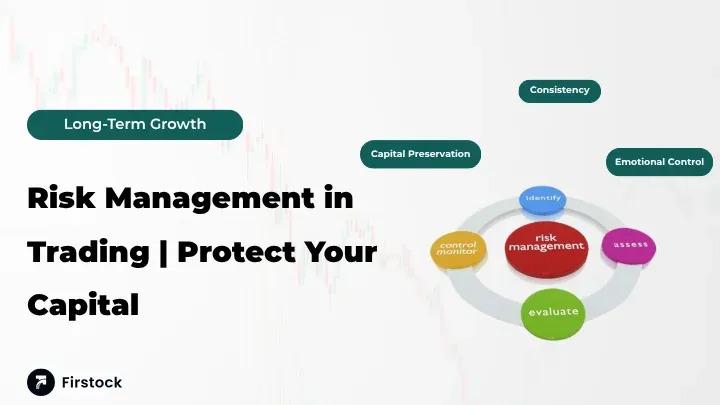What is Risk Management in Trading | Complete Beginner’s Guide

What is Risk Management in Trading: A Complete Beginner’s Guide
When you step into the world of trading, it’s easy to get excited by charts, trends, and quick profits. But let’s pause for a second—would you drive a car without brakes? Probably not. Risk management in trading is like having reliable brakes on a fast car. It doesn’t stop you from moving forward, but it gives you control, safety, and confidence on the road to financial success.
In this article, we’ll explore what is risk management in trading, why it matters, and how you can use simple, practical strategies to protect your money. Whether you're trading through a stock trading app or investing long-term, this guide is designed to help beginners and casual traders understand the basics in a clear, conversational way.
Learn what is risk management in trading, risk management in stock market, financial risk management & smart tips to trade safely using stock trading apps.
Introduction to Risk Management in Trading
Before we dive into strategies, let’s break it down simply. Trading without risk management is like sailing without a compass. The winds of the market can change direction any time, and without a plan, you may end up lost at sea.
Risk management doesn’t eliminate risks—it helps you manage and control them so that a single bad decision doesn’t wipe out your entire investment.
What is Risk Management in Trading?
Risk management in trading is the process of identifying, assessing, and controlling potential losses when buying or selling financial instruments like stocks, forex, or commodities.
Think of it as setting boundaries for your money. You decide:
-
How much you’re willing to lose on each trade.
-
Where to place your stop-loss and take-profit points.
-
How to allocate your capital wisely.
It’s about making decisions with a plan, not emotions.
Why Risk Management Matters
Why do so many traders fail? It’s rarely because they lack knowledge—it’s usually because they don’t manage risk properly.
Here’s why it matters:
-
Protects your capital — Without protection, even a few bad trades can cause huge losses.
-
Keeps you consistent — A disciplined approach helps you avoid panic during market swings.
-
Reduces emotional stress — You trade based on logic, not fear or greed.
-
Survives volatility — Markets can be unpredictable; a solid risk plan keeps you in the game.
The Psychology Behind Risk
Trading is not just about charts; it’s also about your mindset. Many traders let emotions like fear and greed drive decisions.
-
Fear can stop you from taking good opportunities.
-
Greed can make you overtrade or hold on too long.
A good financial risk management strategy acts like an emotional anchor, helping you stay calm and objective even during intense market movements.
Key Principles of Financial Risk Management
Let’s look at the fundamental principles:
-
Capital Preservation – The primary goal is to protect your capital. Profits come later.
-
Risk-Reward Ratio – Always aim for trades where the potential reward outweighs the risk.
-
Consistency Over Time – One big win is nice, but steady, small wins keep you growing.
-
Adaptability – Markets change; your strategy should too.
These principles apply to both seasoned traders and beginners using a stock trading app to place their first orders.
Types of Risks in the Stock Market
Not all risks are the same. Understanding different types helps you plan better:
-
Market Risk: The risk of loss due to market fluctuations.
-
Liquidity Risk: Difficulty selling an asset quickly without loss.
-
Credit Risk: The risk of a counterparty defaulting.
-
Operational Risk: System errors or human mistakes.
-
Systemic Risk: Market-wide shocks like economic crashes or pandemics.
A well-rounded risk management in stock market plan considers all of these.
Position Sizing and Capital Allocation
Imagine you have ₹1,00,000 to trade. Would you invest the entire amount in one stock? Hopefully not.
Position sizing is about deciding how much capital to allocate to each trade. For example:
-
Risking 2% per trade means your maximum loss is ₹2,000 on any single trade.
This ensures that even a few losing trades won’t destroy your account.
Stop-Loss and Take-Profit Strategies
Stop-loss is like a seatbelt in your trading journey. It protects you when things go wrong.
-
Stop-Loss Orders: Automatically close a trade when the price hits a certain level to prevent further loss.
-
Take-Profit Orders: Lock in profits when a stock reaches a target price.
Setting these levels helps you avoid emotional decision-making during market volatility.
Diversification: Don’t Put All Eggs in One Basket
This age-old saying is extremely relevant to risk management.
By diversifying your investments across different sectors, industries, or even asset classes, you reduce the impact if one stock or sector underperforms.
For example:
-
Investing in both IT and Pharma sectors rather than only one.
-
Holding a mix of stocks, bonds, and ETFs.
Risk-Reward Ratio Explained
The risk-reward ratio measures how much you stand to gain for every unit of risk.
For example:
-
Risking ₹1 to make ₹3 gives a 1:3 ratio.
-
A higher ratio means better potential returns relative to the risk.
Successful traders focus on trades with favorable ratios, not just any trade that looks promising.
Practical Risk Management Techniques for Traders
Here are some simple but powerful techniques:
-
Use trailing stop-loss to protect profits as the trade moves in your favor.
-
Avoid overleveraging, especially when using margin accounts.
-
Trade with a plan, not on impulse.
-
Backtest your strategy before risking real money.
-
Keep a trading journal to track decisions and learn from mistakes.
Even if you’re using a stock trading app, these methods apply.
Using Stock Trading Apps for Risk Control
Modern stock trading apps offer built-in tools for financial risk management:
-
Set automatic stop-loss and take-profit levels.
-
Get alerts for price movements.
-
Analyze portfolio risk with charts and insights.
-
Use demo accounts to practice without real losses.
These features help beginners implement risk management in trading effectively, even with little experience.
Common Mistakes Traders Make
Avoid these pitfalls:
-
Skipping stop-losses out of overconfidence.
-
Risking too much on one trade.
-
Revenge trading after a loss.
-
Ignoring market news or global events.
-
Not reviewing performance regularly.
Even experienced traders can fall into these traps without a disciplined approach.
Creating Your Own Risk Management Plan
Here’s a simple structure:
-
Set Clear Goals – Know why you're trading.
-
Define Risk Per Trade – Usually 1–2% of capital.
-
Choose Stop-Loss & Take-Profit Rules – Stick to them.
-
Plan Capital Allocation – Diversify across trades.
-
Monitor & Adjust – Review and adapt regularly.
Your plan should suit your risk tolerance, not someone else’s.
Conclusion
Trading can be exciting, profitable, and rewarding—but only when approached wisely. Risk management in trading is not about avoiding risk completely; it’s about controlling and minimizing it to stay in the game longer.
Think of it like wearing a helmet while riding a bike. It doesn’t stop accidents, but it protects you when they happen.
Whether you’re trading through a stock trading app or investing traditionally, apply these principles to safeguard your capital and build long-term financial strength.
FAQs
1. What is risk management in trading?
Risk management in trading is the process of planning and controlling potential losses through techniques like stop-loss, position sizing, and diversification.
2. Why is risk management important in the stock market?
It helps protect your capital, reduce emotional trading, and ensure you survive market volatility without major losses.
3. How much should I risk per trade?
A common rule is to risk 1–2% of your total capital on any single trade to avoid significant drawdowns.
4. Can I manage risk effectively using a stock trading app?
Yes! Most apps provide tools like stop-loss settings, alerts, portfolio analytics, and demo accounts to help you manage risks easily.
5. What is the best risk-reward ratio for trading?
Many successful traders prefer a 1:2 or higher ratio, meaning the potential reward is at least twice the amount at risk.






